Preamble: This article proposes an idea to promote eco-cultural tourism for visitors to the UNESCO World Heritage Site of Lumbini. Specifically, it highlights initiatives aimed at fostering eco-cultural tourism and educational opportunities in the picturesque hilly districts that surround it. All of these efforts are showcased within the framework of the 'Lumbini Eco-Cultural Circle Experience.' This Lumbini Circle, spanning across six districts, offers visitors a comprehensive range of experiences. These include cultural exploration in the vicinity of Lumbini, traversing hilly terrains, immersing in village life, relishing views of the Himalayan range, embarking on mountain hikes, practicing yoga atop a mountaintop retreat, indulging in a forest bird sanctuary, exploring a charming town, and gaining access to a world-famous wildlife preserve in the plains. All of these adventures can be enjoyed by extending the visit to Lumbini for just a few days and exploring the nearby panoramic holistic hill adventure before returning to Kathmandu. The idea was piloted as a component of a study abroad program designed by the Nepal Study Center (UNM) in collaboration with the local partner college of the PNMF (Siddharthanagar) to promote both the economic development and the community-engaged experiential learning.
Cultural-tourism has been widely discussed as one of Nepal's potential sources of economic growth, particularly considering the country's rich cultural and spiritual landmarks. Chief among these landmarks is the birthplace of Buddha, Lumbini, which holds the prestigious status of a UNESCO World Heritage Site. The development efforts, international support, and global attention devoted to Lumbini have led to the creation of impressive structures such as stupas and meditation halls, along with the gradual growth of various visitor services. Prior to the COVID-19 pandemic, in 2019, Lumbini had attracted as many as 1.5 million tourists, including domestic visitors, for the year before experiencing a sharp decline of up to 80% (source: Lumbini Development Trust). Remarkably, tourists from 113 different countries visited Lumbini last year, with the highest numbers hailing from Sri Lanka, Myanmar, Thailand, China, and Vietnam. The construction of a new international airport near the gateway city of Siddharthanagar underlines the government's commitment to preserving and promoting this cultural treasure.
However, one challenge Lumbini faced was that tourists often limited their stay to just one or two days. The purpose of this article is to explore ways to potentially leverage the natural beauty of the adjoining districts and their ecological landscapes to encourage tourists to venture into a loop across several more districts to the north of Lumbini. In particular, this article discusses an initiative undertaken by the Nepal Study Center aimed at addressing this challenge and enhancing the overall tourism experience. The initiative sought to promote hill adventures and cultural pilgrimages to create an eco-cultural tourism experience for the region, with the hope that it might inspire visitors to extend their stays and contribute to the economic development of the surrounding districts.
To achieve this goal, a three-step strategy was adopted:
1. Research and Planning: The first stage involved conducting research and establishing contacts to create a tentative touring route that included landmarks across the adjoining districts, starting with Rupandehi, Kapilvastu, Gulmi, Arghakachi, Palpa, and Chitwan. This step focused on identifying natural and cultural attractions suitable for tourism.
2. Exploration and Consultation: In the second phase, the team physically explored the districts and engaged in consultations with community leaders and local authorities. This step aimed to assess the feasibility of proposed tourism activities, gather local input, and ensure that plans aligned with the needs and interests of the communities.
3. Academic Program and Promotion: The third phase involved establishing a study abroad program at UNM (University of New Mexico), documenting the journey through a trip travelogue, and developing a tentative website to draw the attention of relevant authorities. This step aimed to promote the newly identified tourist destinations and provide at the same time educational opportunities related to sustainable tourism development. It was tentatively named as the Lumbini Sustainability Circle that documented our educational, cultural, and ecological experiences. The details about itinerary, curricular structure, and community and educational activities can be found at the NSC’s site.
Overall, this collaborative effort by the Nepal Study Center was a proactive approach to extending the benefits of tourism to surrounding regions. It had the potential to increase the duration of tourists' stays, benefiting local communities and contributing to the economic and cultural development of the area while preserving its natural and historical heritage. Additionally, the initiative aimed to encourage academic institutions, both local and international, to recognize the immense potential for their students to immerse themselves in the study and exploration of culture, village life, hill adventures, the magnificent biology of flora and fauna, and wildlife conservation in this unique region.
What follows below is the visual tour of the Lumbini Circle.
Kathmandu: As with any other tourists, we began our cultural exploration in Kathmandu, where we immersed ourselves in the vibrant atmosphere. Our journey included visits to the three Durbar Squares of Kathmandu, Patan, and Bhaktapur, where we marveled at the stunning architecture and bustling marketplaces. Witnessing monkeys in the temple complexes like Swambhunath and Boudhanath and observing people spin prayer wheels in meditative circles was quite surreal.


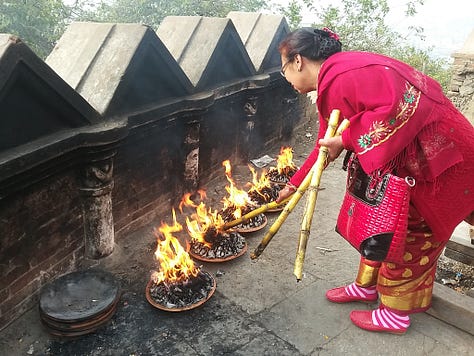
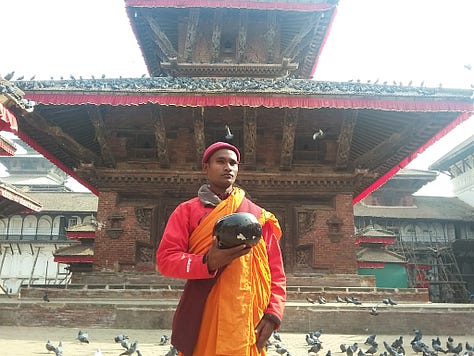
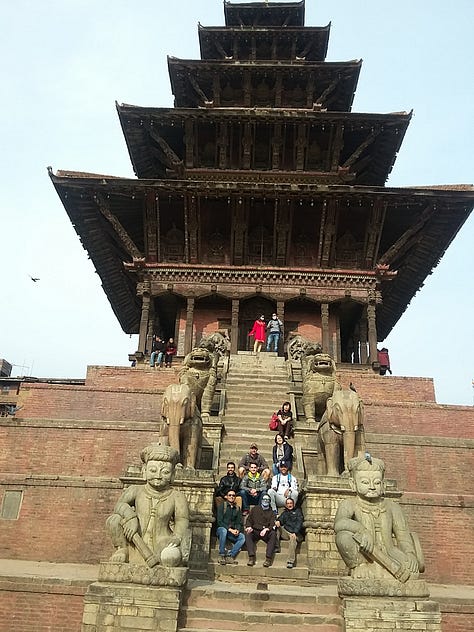
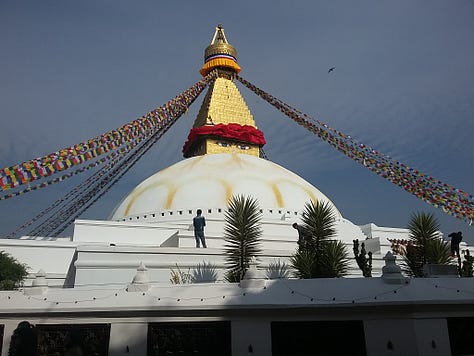
For more photos of the entire loop, please click the link provided at the end of this article.
The highlight was savoring authentic Newari cuisine accompanied by traditional cultural dance performances from different regions of Nepal, offering us a true taste of the local culture. These experiences, just a glimpse of the rich cultural mosaic that Kathmandu has to offer, left a lasting impression on us. However, our adventure continued as we prepared to journey to our next destination, Rupandehi (Lumbini).
Rupandehi: In Rupandehi, our exploration included an educational component. We spent about a week in Siddharthanagar, collaborating with local academic institutions on hands-on STEM projects. We extended invitations to teachers from remote areas like Aglung, Gulmi, to join forces with local school teachers and students in engaging activities such as water quality testing and other data monitoring exercises (air pollution monitoring, ground water level tracking, installing ledger to measure Danda River water level, recycling bins, as well as the installation of public health awareness displays), serving as a pilot for a citizen science project.
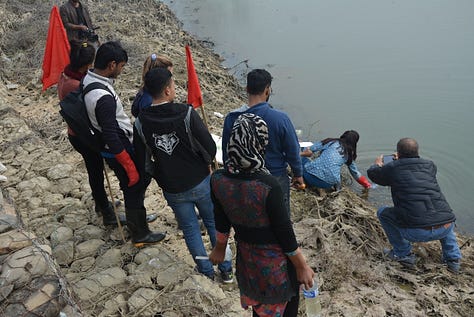

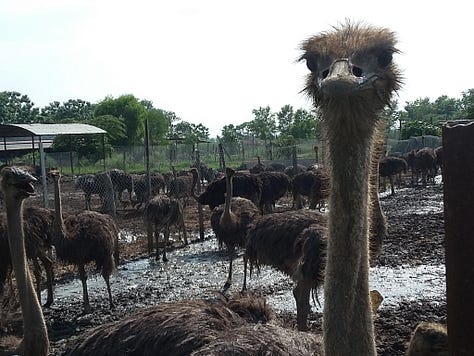
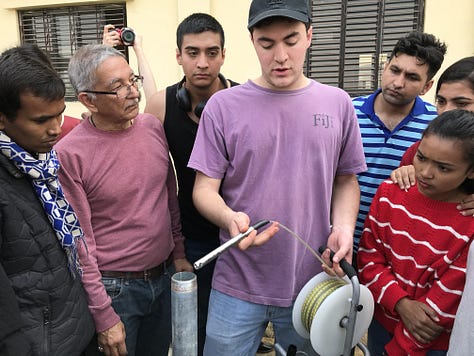


The Mayor of Siddharthanagar, Mr. Hari Prasad Adhikari, expressed great interest in the collaborations between local institutions and international academic entities, such as the University of New Mexico. He was briefed on various projects developed by the two partners, PNMF and NSC (UNM). These projects include the exploration of Lumbini Circle's eco-cultural tourism potential, air and water pollution monitoring and tracking, and the Danda River bio-museum. All of these initiatives aim to promote both economic development and experiential learning through citizen science.
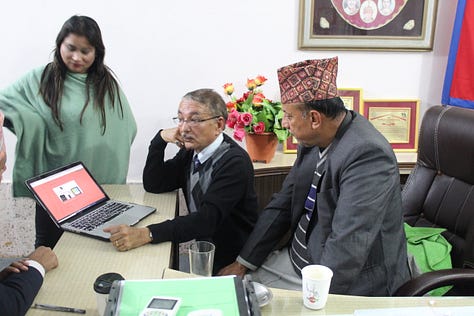
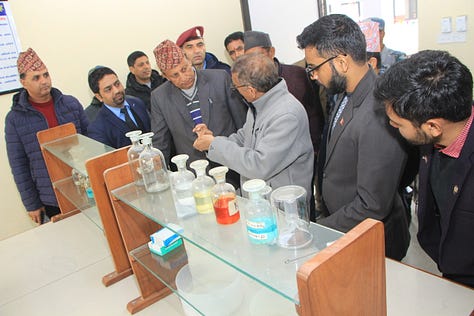

A tentative masterplan, named as the Danda Conservation Plan encompassing many of these citizen science concepts, was presented to the Mayor’s Office for their implementation consideration.
Before heading to Kapilvastu for a cultural exploration of the world-renowned heritage site of Lumbini, we took a detour to visit an ostrich farm in Siddharthanagar. This remarkable and highly successful entrepreneurial venture was initiated by someone who had studied in Australia and imported something quite remarkable from Down Under.
Kapilvastu: In this segment, we had the opportunity to visit three remarkable places. Our first stop was Tilaurakot, the kingdom of Siddhartha’s father, situated in the foothills of the Chure Mountains, approximately 30 kilometers northwest of Lumbini, the birthplace of Buddha. During our journey, we also explored the vicinity and came across Jagadishpur, a large shallow lake resembling a bird sanctuary, bustling with numerous species of birds.
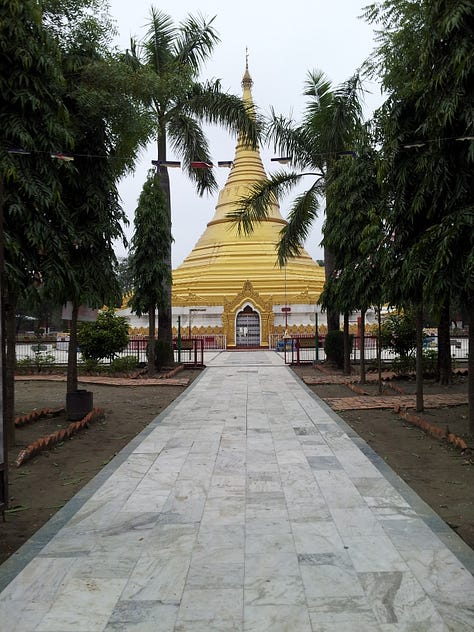
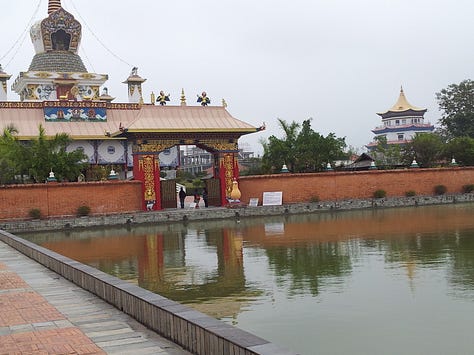
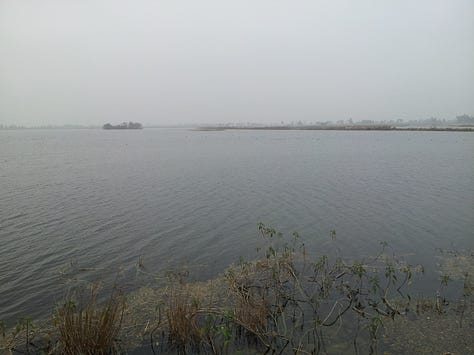
However, the most anticipated part of our visit was to Lumbini itself. It welcomed us with a mesmerizing array of gorgeous monasteries and stupas, each representing different countries from around the world. These structures showcased diverse themes and architectural styles, symbolizing various branches of Buddhism, from Vajrayana to Theravada to Zen. Moving from one structure to another in a tuktuk was an unforgettable experience.
One of the most surreal moments was witnessing the very stone, adorned with gold leaves and paint, marking the birth spot beneath the Maya Devi Temple. It left an unforgettable impression on us. Our journey continued with a road trip, transitioning from the flat Terai of Kapilvastu to the picturesque hilly district of Arghakhachi.
Arghakhachi: Our next destination was the valley town of Sandhikharka, the district headquarters of Arghakhachi. Along the winding road leading to the headquarters, we were treated to breathtaking views of lush green hills, cornfields, terraced farms, and idyllic valleys. One particularly memorable stop was at the Supa Deurali Temple, a revered pilgrimage site for the local communities.
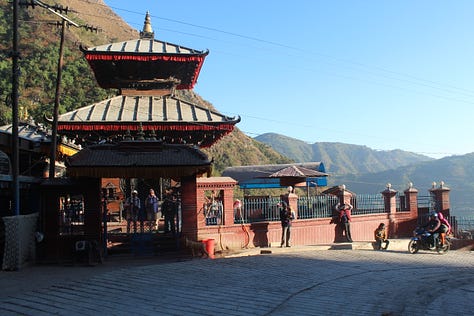
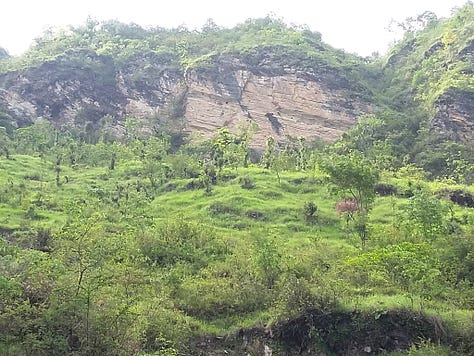

During our visit, we noticed a shadowy silhouette imprinted on a high cliff, resembling an Indian army soldier wearing a typical felt army hat. The story behind this intriguing sight was equally fascinating. Legend has it that Supa Deurali, a goddess known for her ability to grant people's wishes, was betrayed by a young man who had promised to offer gold upon his return after achieving his dream of becoming a Lahure (a soldier in the Indian army). However, he chose not to fulfill his promise, resulting in his body being plastered against the cliff by the powerful Supa Deurali goddess.
The highlight of our visit to the Arghakhachi district was our overnight stay at a hilltop lodge in Narapani just before reaching its headquarter, Sandhikharka valley town. True to the promise made by our trip coordinator, the early morning view of the Himalayan range was absolutely breathtaking. Wrapped in blankets and holding hot coffee in our hands, we eagerly awaited the sunrise and its reflection against the towering Dhaulagiri and other peaks.

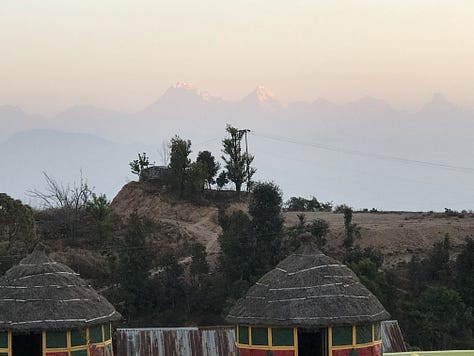
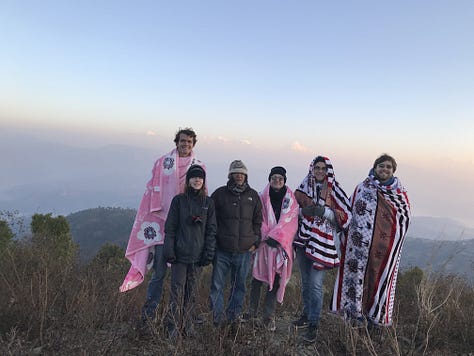
The ever-changing colors of the snowy peaks before us, all within a short span of time, were truly indescribable. To enhance our experience, we downloaded the Peakfinder app on our phones, which helped us identify the numerous peaks that stretched endlessly from left to right.
Before continuing our journey to Madane municipality in the Gulmi District, that afternoon, we embarked on another short uphill trip to a mountain top located to the west of the town of Sandhikharka. The view from the flat, green meadow was absolutely incredible. We even contemplated it as a perfect camping spot for our next visit.
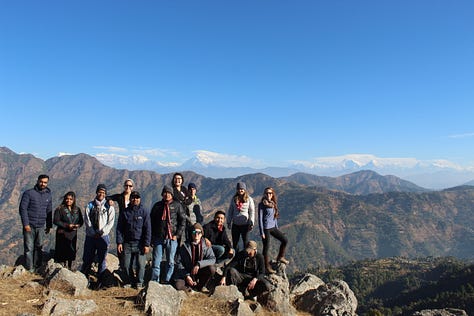
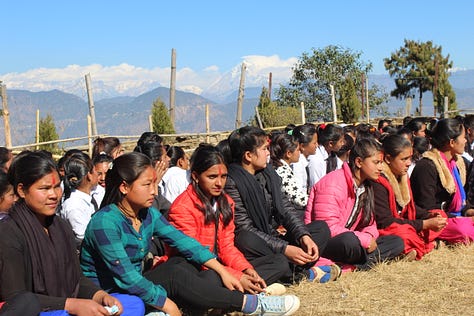

When I heard about the plan to convert this mountaintop beauty into a cricket match field, I was not very thrilled, and I made my concerns known to my friends, who hailed from the region and held important government positions. Our next adventure took us to the district of Gulmi.
While heading back to the valley town of Sandhikharka, we made a stop at an old palace and temple structure to enjoy the mountain view. To our delight, we were greeted by a pair of village singers (Gaine) playing the Sarangi (similar to a violin but held vertically). [For a singing video, please click the link given at the end of this article.]
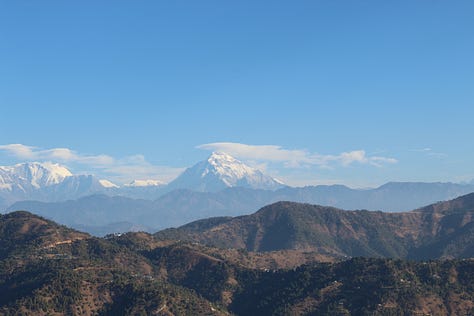
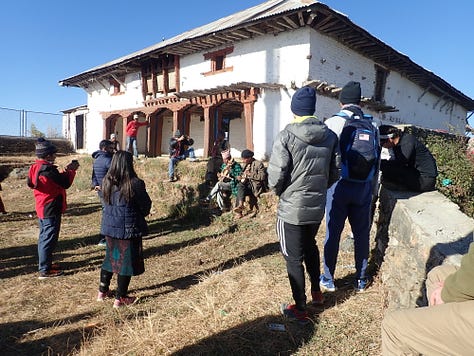
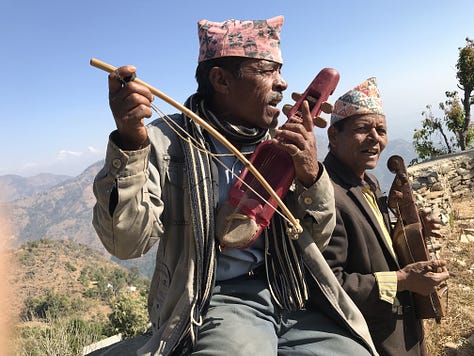
It was quite an experience to listen to their melodious song at the mountain's summit, with the majestic Himalayan range as a breathtaking backdrop. As part of our social engagement, we also visited a local school, where we engaged in a discussion with female students and teachers about gender hygiene. Additionally, we distributed reusable sanitation pads after conducting survey.
Gulmi: As we moved on to the next district further north, Gulmi, our excitement grew as we looked forward to exploring two distinct spots. The first was a mountaintop yoga retreat place known as Arubindo Ashram, and the other was a hike to a mountaintop in its capital, Tamghas, to immerse ourselves in the sounds of birds and the forest (Resunga preserve). During our journey, we also had the opportunity to visit a remarkable clinic in Madane supported by a group of German philanthropists. To our amazement, the clinic was equipped with a highly efficient, non-polluting incinerator for medical waste. This incinerator not only served the clinic but also provided a valuable service to the community by safely disposing of their plastic waste. We were also treated to amazing organic food, primarily sourced from their garden. This included a delicacy that was entirely new to us – ground apple.



Our next destination was the Ashram, visible from the Madane clinic. It featured a whitewashed retaining structure, living quarters, a bright stone-paved but rather steep trail leading to the top of a nearby hill forest, a shrine, and a meditation hall. Our eagerness to leave the clinic and explore this highlight was hardly containable.
After arriving at the meditation center, we were treated to something truly exceptional. The founder of the spiritual retreat, Chandra Mani Bhusal, known as Ramchandra, personally greeted us. What followed was simply priceless – an exquisite spread of organic food, a unique meditation session, and an enlightening narrative of his life journey that unfolded around a crackling bonfire. It couldn't have been any better. Oh yes, we found ourselves washing our own dishes, just as the visiting Prime Minister of Nepal had done a few years earlier.
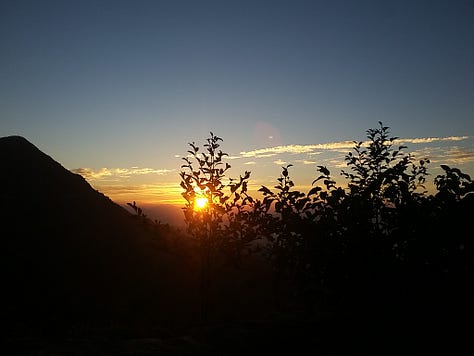
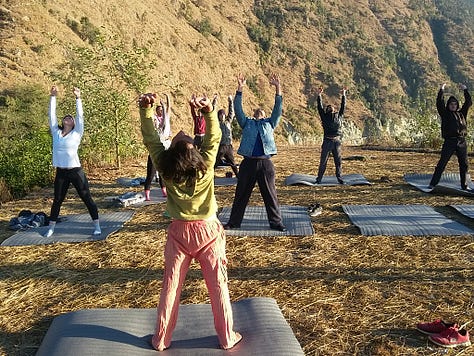

A fluent speaker of five languages, including French, Mr. Bhushal had returned to his village after spending 42 years in India, primarily at the Arubindo Ashram in Pondicherry. His life story, beginning with his departure from the village at the tender age of twelve, followed by his struggles, survival, and the remarkable path that led him to his current state, was nothing short of fascinating.
Quite affordable stay at the retreat was capped with an early morning yoga lesson at a nearby bluff, but not before witnessing a spectacular sunrise. The trip to this spiritual center would not have been complete without knowing about a side hiking trip that took us to a mountain top grassy spot with the entire Dhaulagiri range right in front us.
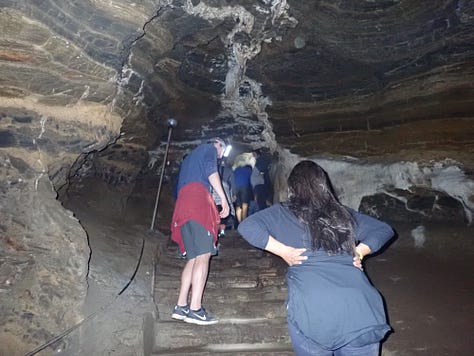
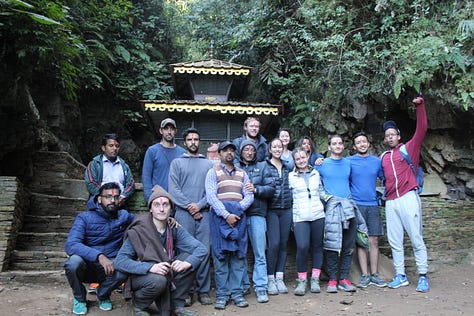
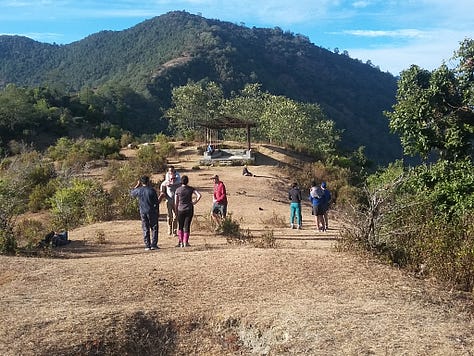
Our next destination was the district headquarter town of Tamghas. Along the way, we made a stop at a cave known as 'Achhambha Ko Gufa.' Despite having previous experiences with massive caves like Carlsbad in New Mexico, what truly struck us was the local people and their community's approach to finding spirituality even within a cave. At the entrance of the dark cave, there was a Shiva temple, symbolizing how Shiva is imagined as a yogi meditating in such a cave. It made us realize that spirituality doesn't need to be prescribed or scripted; it can be experienced anywhere one's heart desires. We felt the same way as we walked through the streets and squares of Kathmandu, often referred to as a living museum. These streets were adorned with countless statues, shrines, stupas, temples, and devoted locals going about their daily rituals and prayers, all amidst the modern hustle and bustle of urban life.
After a brief interaction with the campus students in the morning, we headed uphill to the Serunga preserve. The view below, overlooking the valley town of Tamghas, was truly alluring. About halfway through our mountain climb, we were directed to park our vehicle near a temple complex that also housed a herd of cows. Cows hold a sacred status in Hinduism, and due to their presence in and around the temple, the entire hilltop ecosystem remained pristine, intact, and flourishing.


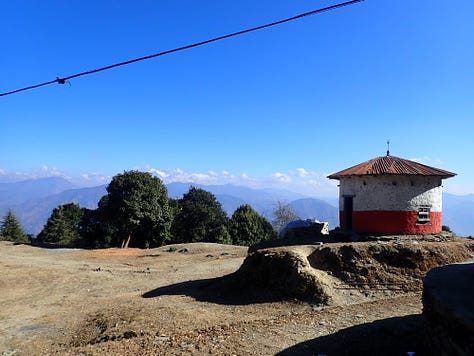
Our hike through the shrubs and trees in silence for about an hour, interrupted only by the chirping of birds and the rustling of the wind, truly evoked a sense of a Japanese ritual I had heard about – forest bathing or shinrin-yoku. Sitting on the grassy knoll after reaching the mountain top and witnessing the view of the Himalayan range in the morning was an indescribable experience. After spending several days in nature and traversing the mountain terrains, we were eager to make our way to the quaint town of Tansen, Palpa, for a hot shower and some relaxation.
Palpa: After spending a night at the district headquarter of Gulmi in the Tamghas valley, we made our way down to the spiritual town of Ridi. Here, one can find the sacred confluence of the Kali Gandaki River and Ridikhola. This site draws numerous Hindu pilgrims who come to cleanse themselves of sins, perform last rites, and celebrate the circle of life.
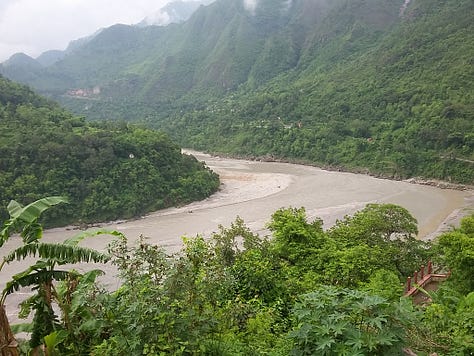
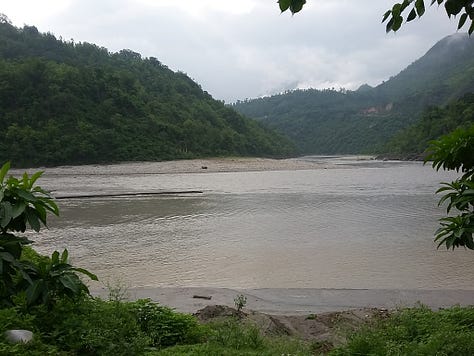
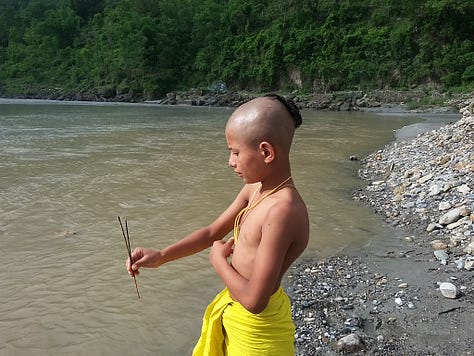
After spending a brief moment at the river bank, our next destination was Tansen. This beautiful hilly town with sloping streets and colorful bazars is famous for the local craftsmanship in a particular type of fabric (Dhaka) and the hand-made brass water spouts, vases and cookware. The hill side ledges are dotted with lodges and other recreation amenities with the magnificent view of Dhaulagiri mountain range as the backdrop.

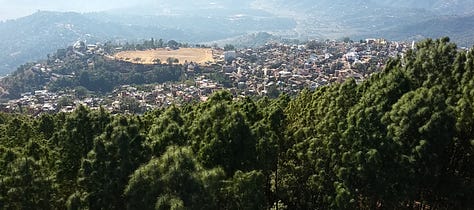
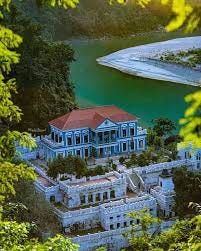
Situated at an altitude of about 4500 ft. the town has a perfect sunny weather all year around making it a perfect getaway spots for the people of hot and humid plain in the south. After several days of mountainous experiences, including hiking and yoga, the quaint town of Tansen provided us with the perfect opportunity to relax. We made a brief stop for lunch at a restaurant situated atop a hill, appropriately named Windy Hill (Batase Danda), with the majestic mountain range serving as a breathtaking backdrop. It was a truly satisfying experience.
Within a half-hour to an hour's drive from Tansen, there truly lies a hidden gem known as the Queen's Palace (Rani Mahal) at the base of the north side of the mountain by the Kali Gandaki River. The palace was built by Khadga Samsher Rana in memory of his youngest wife, Tej Kumari Devi. In 1885, he was banished from the capital as a result of his involvement in a palace power struggle.
Our final destination in the loop was the wildlife preserve of Chitwan National Park.
Chitwan: After indulging in a rich cultural exposure, mountain hikes, Himalayan range views, and mountain-top yoga at a spiritual retreat, our journey reached its culmination with a visit to Chitwan National Park, located about three hours away from the town of Tansen. The park offered various touring options to immerse in its wildlife, including elephant rides, jungle walks, forest drives to a gharial farm, and early-morning canoe rides.
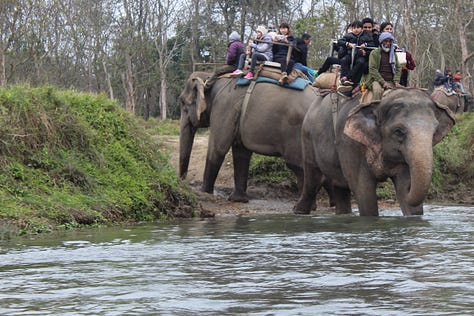


We chose to embark on an elephant ride, during which we were fortunate to spot several rhinos and a few deer. The early-morning canoe ride provided us with a unique opportunity to observe a wide array of bird species and numerous gharials basking on the riverbank, soaking in the warmth of the early morning sun. Our park tour was further enriched with a visit to a Tharu museum, where we gained insights into the indigenous Tharu people of the Terai, who have thrived in the dense forested flatlands for millennia.
The day was wonderfully capped with a vibrant cultural program in the evening, showcasing the traditions and heritage of the Tharu community. The touring loop ended with a flight back from Chitwan to Kathmandu
Termed as the Lumbini Sustainability Circle by our team, this trip and the travelogue presented above were part of a Himalayan Study Abroad Program with three main objectives. The first objective was to engage visiting UNM students in a series of hands-on community-engaged projects and activities, in collaboration with the local host organization PNMF and its college. The second objective was to provide students with the opportunity to immerse themselves in the diverse cultural, natural, and village experiences offered across different landscapes. The third objective aimed to experiment with and disseminate information about the potential of a multi-district touring loop to extend tourism opportunities for visitors to Lumbini. We hope that the concerned authorities, business and tour agencies at the local and national levels will take some lessons from our experience. The national and international educational institutions can also benefit from this to design their own educational trips that can be highly beneficial to all parties involved.
For more photos of the above winter travelogues, please click here.
For photos of the summer Lumbini Circle scouting visit to explore eco-cultural tourism potential, please click here.
Acknowledgments: I would like to express my gratitude to the local NGO PNMF of Siddharthanagar, which provided logistical support in organizing an exploratory team. This team included myself, a former Finance Secretary, Mr. Yubaraj Bhushal, and Mr. Dornath Aryal, who was a Senior Under-Secretary from the Ministry of Foreign Affairs at the time and is currently the Nepalese Ambassador to Oman. Subsequently, PNMF also offered support and coordination for the UNM team during the tour, with key members including Ms. Swati Thapa, Prakash Adhikari, Dharma KC, as well as several staff and students from PNMF's college. Last but not least, I want to express my gratitude for the support of the University of New Mexico community, particularly the Department of Economics, its staff, and students.







